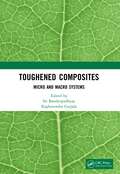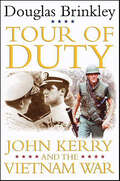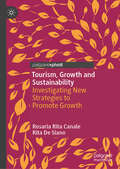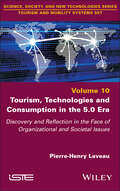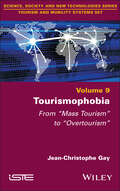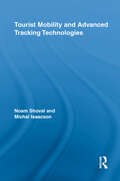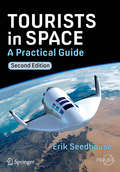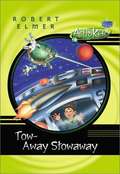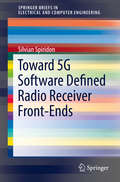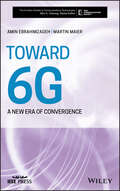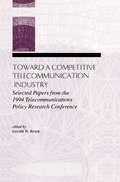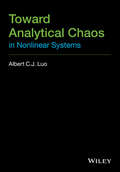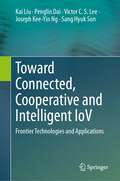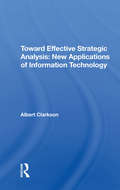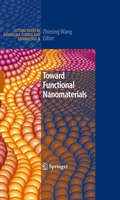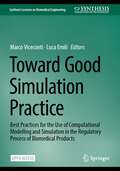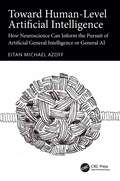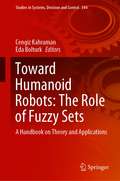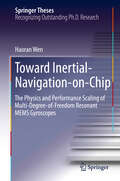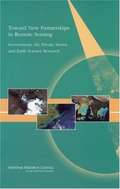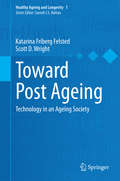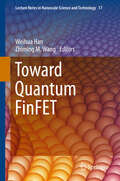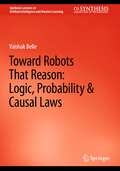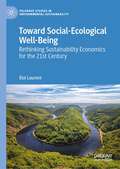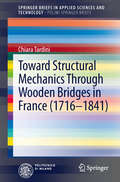- Table View
- List View
Toughened Composites: Micro and Macro Systems
by Sri Bandyopadhyay Raghavendra GujjalaThis book covers micro and macro aspects of toughened composites covering polymer matrix, metal matrix, ceramic matrix and nanomatrix. It gives the reader understanding of composite fabrication, construction, and lightweight yet high crack resistance performance, macroscopic testing supported by microscopic bonding and debonding features, models of stress transfer, and commercial features of developing cheaper yet high-quality materials. Features: Focuses on micro and macro aspects of toughening methods and principles of composite materials. Includes all types of composites including polymer matrix, metal matrix, ceramic matrix and nanomatrix. Covers corrosion resistance and oxidation resistance as well as solubility resistance. Discusses the use of recycled materials. Provides a good balance of long fibre, short fibre, nanoparticle and particulate modifiers. This book aims at researchers and professionals in materials science, composite materials, fracture mechanics, materials characterization and testing, properties and mechanics, nanomaterials, aerospace and automotive engineering and structural engineering.
Tour of Duty: John Kerry and the Vietnam War
by Douglas BrinkleyOne of our most acclaimed historians explores the decorated military service of one of America’s most intriguing politicians—the leading Democratic presidential candidate for 2004—and its profound effects on his career and lifeIn Tour of Duty, Brinkley explores Senator John Kerry’s career and deftly deals with such explosive issues as U.S. atrocities in Vietnam and the bombing of Cambodia. Using new information acquired from the recently released Nixon tapes, Brinkley reveals how White House aides Charles Colson and H.R. Haldeman tried to discredit Kerry. Refusing to be intimidated, Kerry started running for public office, eventually becoming a U.S. Senator from Massachusetts. Covering more than four decades, this is the first full-scale definitive account of Kerry’s journey from war to peace. In writing this riveting, action-packed narrative, Brinkley has drawn on extensive interviews with virtually everyone who knew Kerry well in Vietnam. Kerry also relegated to Brinkley his letters home from Vietnam and his voluminous “war notes” journals, notebooks, and personal reminiscences written during and shortly after the war. This material was provided without restriction, to be used at Brinkley’s discretion, and has never before been published.
Tourism, Growth and Sustainability: Investigating New Strategies to Promote Growth
by Rosaria Rita Canale Rita De SianoThis book proposes a reconstruction of the relationship between tourism, growth and sustainability. Drawing on theoretical as well as applied perspectives, the authors provide analytical tools to investigate connections at the heart of policy debate, in search of new strategies to promote growth. With a special focus on climate change, readers will be able to understand, by using simple yet rigorous analytical tools, the interpretative categories used to measure and evaluate tourism's contribution to growth and its impact on environmental transformation and climate change. The book explores what role tourism has in developing and emerging economies, and how advanced economies can rely on tourism to foster growth and reduce inequality. A valuable contribution to tourism and sustainability literature, this book aims to support policymakers in identifying strategies that combine sustainability and tourism with profitability and development of the territory.
Tourism, Technologies and Consumption in the 5.0 Era: Discovery and Reflection in the Face of Organizational and Societal Issues (ISTE Invoiced)
by Pierre-Henry LeveauHistory shows us that technologies help humankind in our daily activities. Every major technological evolution brings about an economic, cultural and social revolution, transforming the lifestyles of citizens, professional organizations and consumer practices. Digital technologies are a perfect illustration of this, and tourism is no exception. Soon, the technologies of the "X.0" generation (AI, cobots, biotechnologies, etc.) will herald a new socio-technological revolution, ushering in the 5.0 era. Tourism, Technologies and Consumption in the 5.0 Era explores the role and challenges of new technologies in “Society 5.0”, which is gradually transforming the practices of both tourism professionals and travelers. Faced with the challenges of climate change and sustainable development, it examines the opportunities and limits of bionumeric technologies for more sustainable and responsible tourism. This book helps us decipher a world in transition, where digital technologies will reinvent consumer experiences, particularly in tourism, and encourage more socially responsible behavior.
Tourismophobia: From "Mass Tourism" to "Overtourism" (ISTE Consignment)
by Jean-Christophe GayAt the heart of “tourismophobia”, past and present, is the question of the masses and the differentiation between those who call themselves “travellers”, denying their own tourism, and tourists. Tourismophobia studies the persistence of the repulsion for them, and though their number is infinitely greater today, they are no longer socially the same and practices have radically changed. This book brings this cultural invariant out of the shadows to understand the driving forces behind this social posture, which has taken a new turn with climate change. Without overlooking the negative effects of tourism, this book is a response to the current debate on “overtourism”, which is the most contemporary form of tourismophobia.
Tourist Mobility and Advanced Tracking Technologies (Routledge Advances in Tourism #19)
by Noam Shoval Michal IsaacsonThe remarkable developments in tracking technologies over the past decade have opened up a wealth of possibilities in terms of research into tourist spatial behaviour. To date, most research in the field has been based on data derived from less objective – hence methodologically problematic – sources. This book examines the various technologies available to track pedestrians and motorized vehicles as well as the moral, ethical and legal issues arising from the utilization of data thus obtained. The methodologies outlined in the book could prove revolutionary in terms of tourism research, management and planning.
Tourists in Space
by Erik SeedhouseForget Hawaii or the Mediterranean. Soon - very soon - you'll be able to add a much more exotic stamp to your passport: space. How will you get there, what will the trip be like and how much training will you need? All you need to know is right here in this guide. Tourists in Space: A Practical Guide supplies all the advice and information you need to make your spaceflight the most rewarding experience of your life. This definitive, real-world guide is packed with helpful facts and suggestions on everything from training, equipment, safety and in-flight procedures to techniques for avoiding space motion sickness and bone demineralization. You'll also find: * Advice on choosing your training agency * Techniques for minimizing the risk of space motion sickness * Information you need to prepare for your medical examination, training and flight * Tips on activities near your training location and much more.
Tow-away Stowaway (AstroKids #10)
by Robert ElmerBook 10 of AstroKids. Yearning for his own adventure, Tag takes his sister's space scooter for a ride and ends up trapped on a vessel that only serves Cheez Whiz. He knows he's in deep-space trouble, but he also knows that with God, he's never really alone.
Toward 5G Software Defined Radio Receiver Front-Ends
by Silvian SpiridonThis book introduces a new intuitive design methodology for the optimal design path for next-generation software defined radio front-ends (SDRXs). The methodology described empowers designers to "attack" the multi-standard environment in a parallel way rather than serially, providing a critical tool for any design methodology targeting 5G circuits and systems. Throughout the book the SDRX design follows the key wireless standards of the moment (i. e. , GSM, WCDMA, LTE, Bluetooth, WLAN), since a receiver compatible with these standards is the most likely candidate for the first design iteration in a 5G deployment. The author explains the fundamental choice the designer has to make regarding the optimal channel selection: how much of the blockers/interferers will be filtered in the analog domain and how much will remain to be filtered in the digital domain. The system-level analysis the author describes entails the direct sampling architecture is treated as a particular case of mixer-based direct conversion architecture. This allows readers give a power consumption budget to determine how much filtering is required on the receive path, by considering the ADC performance characteristics and the corresponding blocker diagram.
Toward 6G: A New Era of Convergence (The ComSoc Guides to Communications Technologies)
by Martin Maier Amin EbrahimzadehThe latest developments and recent progress on the key technologies enabling next-generation 6G mobile networks Toward 6G: A New Era of Convergence offers an up-to-date guide to the emerging 6G vision by describing new human-centric services made possible by combinations of mobile robots, avatars, and smartphones, which will be increasingly replaced with wearable displays and haptic interfaces that provide immersive extended reality (XR) experiences. The authors—noted experts on the topic—include a review of their work and information on the recent progress on the Tactile Internet and multi-sensory haptic communications. The book highlights decentralized edge computing in particular via Ethereum blockchain technologies, most notably the so-called decentralized autonomous organization (DAO) for crowdsourcing of human skills to solve problems that machines (such as autonomous artificial intelligence agents and robots) alone cannot solve well. The book also contains a review of the most recent and ongoing work on XR (including virtual/augmented/mixed reality). Specifically, the book describes the implications of the transition from the current gadgets-based Internet to a future Internet that is evolving from bearables (such as smartphones), moves towards wearables (for example Amazon's recently launched voice-controlled Echo Loop ring, glasses, and earbuds), and then finally progresses to nearables with embedded computing technologies and intelligent provisioning mechanisms for the delivery of human-intended services, including sixth-sense perceptions, in a 6G post-smartphone era. This important text: Offers a review of the 6G network architectures and key enabling technologies Explains why 6G should not be a mere exploration of more spectrum at high-frequency bands, but rather a convergence of upcoming technological trends Describes the Tactile Internet's human-in-the-loop centric design principles and haptic communications models Includes analytical frameworks to estimate the fluid orchestration of human + machine co-activities across unified communication network infrastructures Explores the performance gains of cooperative computation offloading with communications and computation limitations in both fronthaul and backhaul Written for students, network researchers, professionals, engineers, and practitioners, Toward 6G: A New Era of Convergence explores the most recent advances on the key technologies enabling next-generation 6G mobile networks, with an emphasis on their seamless convergence.
Toward A Competitive Telecommunication Industry: Selected Papers From the 1994 Telecommunications Policy Research Conference (LEA Telecommunications Series)
by Gerald W. BrockProviding an authoritative perspective on the best current research regarding telecommunication policy, this book is based on the 22nd Annual Telecommunications Policy Research Conference. The papers focus on the critical policy issues created by increasing competition in the industry. The book contains a careful analysis of local competition and interconnection, international competition, universal service issues, the Internet and emerging new methods of communication, and the first amendment problems created by changing telecommunication technology. It brings together -- in a convenient form -- a wide range of important scholarship on telecommunication policy that otherwise would require extensive research into a variety of journals, government filings, and unpublished papers.
Toward Analytical Chaos in Nonlinear Systems
by Albert C. LuoExact analytical solutions to periodic motions in nonlinear dynamical systems are almost not possible. Since the 18th century, one has extensively used techniques such as perturbation methods to obtain approximate analytical solutions of periodic motions in nonlinear systems. However, the perturbation methods cannot provide the enough accuracy of analytical solutions of periodic motions in nonlinear dynamical systems. So the bifurcation trees of periodic motions to chaos cannot be achieved analytically. The author has developed an analytical technique that is more effective to achieve periodic motions and corresponding bifurcation trees to chaos analytically. Toward Analytical Chaos in Nonlinear Systems systematically presents a new approach to analytically determine periodic flows to chaos or quasi-periodic flows in nonlinear dynamical systems with/without time-delay. It covers the mathematical theory and includes two examples of nonlinear systems with/without time-delay in engineering and physics. From the analytical solutions, the routes from periodic motions to chaos are developed analytically rather than the incomplete numerical routes to chaos. The analytical techniques presented will provide a better understanding of regularity and complexity of periodic motions and chaos in nonlinear dynamical systems. Key features: Presents the mathematical theory of analytical solutions of periodic flows to chaos or quasieriodic flows in nonlinear dynamical systems Covers nonlinear dynamical systems and nonlinear vibration systems Presents accurate, analytical solutions of stable and unstable periodic flows for popular nonlinear systems Includes two complete sample systems Discusses time-delayed, nonlinear systems and time-delayed, nonlinear vibrational systems Includes real world examples Toward Analytical Chaos in Nonlinear Systems is a comprehensive reference for researchers and practitioners across engineering, mathematics and physics disciplines, and is also a useful source of information for graduate and senior undergraduate students in these areas.
Toward Connected, Cooperative and Intelligent IoV: Frontier Technologies and Applications
by Kai Liu Penglin Dai Victor C.S. Lee Joseph Kee-Yin Ng Sang Hyuk SonThis book offers a comprehensive introduction to technological advances in Internet of Vehicles (IoV), including vehicular communications, vehicular system architectures, data dissemination algorithms, resource allocation schemes, and AI-enabled applications. It focuses on the state-of-the-art IoV with regard to three major directions, namely networking, cooperation, and intelligence, including advanced wireless communication technologies, algorithm theory, optimization mechanisms, and AI technologies. In addition, the book includes a number of case studies with system prototype implementation and hands-on experiments in IoV, making it suitable both as a technical reference work for professionals and as a textbook for graduate students.
Toward Effective Strategic Analysis: New Applications Of Information Technology
by Albert ClarksonExploring the future of strategic analysis, this book identifies problems at the heart of the historical U.S. failure to perform effective strategic analysis, then explains and dramatizes how new applications of information technology can make significant progress possible. Certain specific limitations of human memory, says the author, are major ca
Toward Functional Nanomaterials
by Zhiming M WangThrough advanced characterization and new fabrication techniques, nanostructured materials have become a central focus of investigation in materials science, chemistry, physics, and engineering. Nanomaterials with a range of morphologies and compositions have been shown to display varied functionality in areas such as electronic structure, optical effects, and spin dynamics. This book presents a detailed overview of recent research developments on functional nanomaterials, including synthesis, characterization, and applications. A series of chapters provides state-of-the-art information on oxide nanoparticles, metal nanostructures, semiconductor nanocrystals, and polymer nanocomposites.
Toward Good Simulation Practice: Best Practices for the Use of Computational Modelling and Simulation in the Regulatory Process of Biomedical Products (Synthesis Lectures on Biomedical Engineering)
by Marco Viceconti Luca EmiliThis open access book, the Community of Practice led by the VPH Institute, the Avicenna Alliance, and the In Silico World consortium has brought together 138 experts in In Silico Trials working in academia, the medical industry, regulatory bodies, hospitals, and consulting firms. Through a consensus process, these experts produced the first attempt to define some Good Simulation Practices on how to develop, evaluate, and use In Silico Trials. Good Simulation Practice constitutes an indispensable guide for anyone who is planning to engage at any title with In Silico Trials.
Toward Human-Level Artificial Intelligence: How Neuroscience Can Inform the Pursuit of Artificial General Intelligence or General AI
by Eitan Michael AzoffIs a computer simulation of a brain sufficient to make it intelligent? Do you need consciousness to have intelligence? Do you need to be alive to have consciousness? This book has a dual purpose. First, it provides a multi-disciplinary research survey across all branches of neuroscience and AI research that relate to this book’s mission of bringing AI research closer to building a human-level AI (HLAI) system. It provides an encapsulation of key ideas and concepts, and provides all the references for the reader to delve deeper; much of the survey coverage is of recent pioneering research. Second, the final part of this book brings together key concepts from the survey and makes suggestions for building HLAI. This book provides accessible explanations of numerous key concepts from neuroscience and artificial intelligence research, including: The focus on visual processing and thinking and the possible role of brain lateralization toward visual thinking and intelligence. Diffuse decision making by ensembles of neurons. The inside-out model to give HLAI an inner "life" and the possible role for cognitive architecture implementing the scientific method through the plan-do-check-act cycle within that model (learning to learn). A neuromodulation feature such as a machine equivalent of dopamine that reinforces learning. The embodied HLAI machine, a neurorobot, that interacts with the physical world as it learns. This book concludes by explaining the hypothesis that computer simulation is sufficient to take AI research further toward HLAI and that the scientific method is our means to enable that progress. This book will be of great interest to a broad audience, particularly neuroscientists and AI researchers, investors in AI projects, and lay readers looking for an accessible introduction to the intersection of neuroscience and artificial intelligence.
Toward Humanoid Robots: A Handbook on Theory and Applications (Studies in Systems, Decision and Control #344)
by Cengiz Kahraman Eda BolturkThis book offers a comprehensive reference guide for modeling humanoid robots using intelligent and fuzzy systems. It provides readers with the necessary intelligent and fuzzy tools for controlling humanoid robots by incomplete, vague, and imprecise information or insufficient data, where classical modeling approaches cannot be applied. The respective chapters, written by prominent researchers, explain a wealth of both basic and advanced concepts including fuzzy control, metaheuristic-based control, neutrosophic control, etc. To foster reader comprehension, all chapters include relevant numerical examples or case studies. Taken together, they form an excellent reference guide for researchers, lecturers, and postgraduate students pursuing research on humanoid robots. Moreover, by extending all the main aspects of humanoid robots to its intelligent and fuzzy counterparts, the book presents a dynamic snapshot of the field that is expected to stimulate new directions, ideas, and developments.
Toward Inertial-Navigation-on-Chip: The Physics and Performance Scaling of Multi-Degree-of-Freedom Resonant MEMS Gyroscopes (Springer Theses)
by Haoran WenThis thesis develops next-generation multi-degree-of-freedom gyroscopes and inertial measurement units (IMU) using micro-electromechanical-systems (MEMS) technology. It covers both a comprehensive study of the physics of resonator gyroscopes and novel micro/nano-fabrication solutions to key performance limits in MEMS resonator gyroscopes. Firstly, theoretical and experimental studies of physical phenomena including mode localization, nonlinear behavior, and energy dissipation provide new insights into challenges like quadrature errors and flicker noise in resonator gyroscope systems. Secondly, advanced designs and micro/nano-fabrication methods developed in this work demonstrate valuable applications to a wide range of MEMS/NEMS devices. In particular, the HARPSS+ process platform established in this thesis features a novel slanted nano-gap transducer, which enabled the first wafer-level-packaged single-chip IMU prototype with co-fabricated high-frequency resonant triaxial gyroscopes and high-bandwidth triaxial micro-gravity accelerometers. This prototype demonstrates performance amongst the highest to date, with unmatched robustness and potential for flexible substrate integration and ultra-low-power operation. This thesis shows a path toward future low-power IMU-based applications including wearable inertial sensors, health informatics, and personal inertial navigation.
Toward New Partnerships In Remote Sensing: Government, the Private Sector, and Earth Science Research
by Steering Committee on Space Applications CommercializationInformation on the Government, the Private Sector, and Earth Science Research
Toward Post Ageing
by Scott D. Wright Katarina Friberg FelstedThis book examines the emergent and expanding role of technologies that hold both promise and possible peril for transforming the ageing process in this century. It discusses the points and counterpoints of technological advances that would influence a reconstruction of what it means to age when embedded in a post-human vision for a post-biological future. The book presents a provocative interdisciplinary meta-analysis that contrasts paradigms with inflection points, making the case that society has entered a new inflection point, provisionally labeled as Post Ageing. It goes on to discuss the moderate and radical versions of this inflection point and the philosophical issues that need to be addressed with the advent of post ageing activities: postponing and possibly ending ageing, primarily through technological advances. This book will be a valuable resource for professionals who wish to review the continuum of varied constructs and intersects of technologies ranging from those purporting to enhance the activities of daily living in older adults, to those that would enable the older worker to stay competitive in the labor market, to those that propose to extend longevity and ultimately, claim to transcend ageing itself--moving toward a transhumanistic domain and more specifically, a post-ageing inflection point.
Toward Quantum FinFET
by Zhiming M. Wang Weihua HanThis book reviews a range of quantum phenomena in novel nanoscale transistors called FinFETs, including quantized conductance of 1D transport, single electron effect, tunneling transport, etc. The goal is to create a fundamental bridge between quantum FinFET and nanotechnology to stimulate readers' interest in developing new types of semiconductor technology. Although the rapid development of micro-nano fabrication is driving the MOSFET downscaling trend that is evolving from planar channel to nonplanar FinFET, silicon-based CMOS technology is expected to face fundamental limits in the near future. Therefore, new types of nanoscale devices are being investigated aggressively to take advantage of the quantum effect in carrier transport. The quantum confinement effect of FinFET at room temperatures was reported following the breakthrough to sub-10nm scale technology in silicon nanowires. With chapters written by leading scientists throughout the world, Toward Quantum FinFET provides a comprehensive introduction to the field as well as a platform for knowledge sharing and dissemination of the latest advances. As a roadmap to guide further research in an area of increasing importance for the future development of materials science, nanofabrication technology, and nano-electronic devices, the book can be recommended for Physics, Electrical Engineering, and Materials Science departments, and as a reference on micro-nano electronic science and device design. Offers comprehensive coverage of novel nanoscale transistors with quantum confinement effect Provides the keys to understanding the emerging area of the quantum FinFET Written by leading experts in each research area Describes a key enabling technology for research and development of nanofabrication and nanoelectronic devices
Toward Robots That Reason: Logic, Probability & Causal Laws (Synthesis Lectures on Artificial Intelligence and Machine Learning)
by Vaishak BelleThis book discusses the two fundamental elements that underline the science and design of artificial intelligence (AI) systems: the learning and acquisition of knowledge from observational data, and the reasoning of that knowledge together with whatever information is available about the application at hand. It then presents a mathematical treatment of the core issues that arise when unifying first-order logic and probability, especially in the presence of dynamics, including physical actions, sensing actions and their effects. A model for expressing causal laws describing dynamics is also considered, along with computational ideas for reasoning with such laws over probabilistic logical knowledge.
Toward Social-Ecological Well-Being: Rethinking Sustainability Economics for the 21st Century (Palgrave Studies in Environmental Sustainability)
by Éloi LaurentThis book investigates the deep economic causes of environmental unsustainability and offers a new vision to rebuild sustainability economics. While sustainability scholars are hard at work with documenting the tangible systemic crisis of our Biosphere, the economic roots of this crisis are rarely exposed, examined nor addressed. This book’s central contribution to sustainability studies is to argue that what we should sustain is not economic growth but social-ecological well-being defined as a combination of planetary health, cooperation and justice resulting in human holistic prosperity. The long-term prosperity of humanity indeed relies on generating health and fostering cooperation informed by justice: social-ecological well-being should be the cornerstone of sustainability economics for the 21st century. Within this framework, this book attempts to explain why the three key dimensions of sustainability are jointly in crisis, show what vision can articulate those dimensions to rethink sustainability economics for our century, what practical policies should be undertaken to give life to these visions before concluding on the need to reinvent the narratives that sustain economic analysis.
Toward Structural Mechanics Through Wooden Bridges in France (1716-1841)
by Chiara TardiniEarly applications of Navier's beam theory to the rational design of structures are documented in the Annales of the French Ecole des Ponts et Chaussées and refer to the design of three wooden bridges built in France in the 1840's. Revisiting these examples, the book provides documentation on the progressive establishment of the new design approach, based on the theory of structural mechanics rather than empirical knowledge. The bridges concerned were built according to the structural scheme patented by Ithiel Town in the USA, witnessing the diffusion in Europe of the American advancements in bridge design, circulated by the travel reports of French engineers from the Ecole. Through the exam of French treatises discussing the progress of theoretical formulations in parallel with experimental findings in the 18th and 19th centuries, the book retraces as well the long path which led to the formulation of Navier's theory. The relevant scientific debate dealt mainly with the specific case of wood bridges; the text outlines a brief history of bridges built in the Alpine area at the time, based on unpublished iconographic materials from various European archives.
